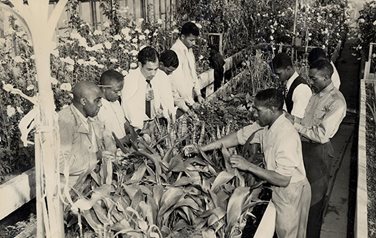GRDI consists of the following entities: Agricultural and Environmental Research Station, West Virginia State University Extension Service, and the Center for the Advancement of Science, Technology, Engineering & Mathematics.
The Gus R. Douglass Land-Grant Institute (GRDI) is home to WVSU’s land-grant administrative area. GRDI is named in honor of Gus Douglass, who served as the State Commissioner of Agriculture for over four decades.
You’ve probably heard WVSU referred to as a “land-grant university,” but what does that mean? In 1862, President Abraham Lincoln signed into law the first Morrill Act, which “granted land” to states for the purpose of establishing institutions of higher education that focused on teaching military tactics, engineering and agriculture. West Virginia University, our state’s only other land-grant institution, was established under the Morrill Act.
Then, in 1890, a second Morrill Act was passed. This one focused on providing educational opportunities specifically to African-American citizens and established WVSU, then called the West Virginia Colored Institute. (Another act was passed in 1994 that targeted Native American institutions.) Other important Congressional acts followed, like the Smith-Lever Act of 1914, which established the cooperative extension system.
So that’s how WVSU was established as a land-grant university. The historical term has stuck and continues to be an integral part of the mission of WVSU. Today, we fulfill the land-grant mission of research, teaching and extension in a variety of ways, which you can learn about by exploring our website.
History
West Virginia State University was designated by the United States Congress and the State of West Virginia as an 1890 Land-Grant Institution under the Second Morrill Act. These schools were created to provide “instruction in agriculture, the mechanical arts, English language and the various branches of mathematical, physical, natural and economic science: to the black citizens of the state where these students had no access to other higher education institutions.”
WVSU faithfully and successfully met its duties to the citizens of West Virginia as a land-grant university in an outstanding manner. However, on October 23, 1956, the West Virginia State Board of Education voted to surrender the land-grant status of WVSU (effective July 1, 1957) and transfer all personnel and expense funds to West Virginia University, the state’s 1862 Land-Grant Institution.
For decades, alumni of the University interested in regaining the Institution’s land-grant status looked for the right time, place, and person(s) to reverse the decision made in 1957. In 1988, President Hazo W. Carter Jr. undertook this endeavor. That fall, he and several members of his staff traveled to Washington to meet with the staffs of West Virginia’s Congressional delegates and representatives of the Secretary of the USDA to explore the feasibility of regaining land-grant status. The Congressional delegation was supportive, but pointed out the first step was to have the state legislature re-designate WVSU as an 1890 Land-Grant Institution.
In 1991, House Bill 2124 was passed unanimously by both the House and Senate after being amended twice, to re-designate WVSU as an 1890 Land-Grant Institution. On February 12, 1991, Governor Gaston Caperton signed the bill on the campus.
On August 4, 1999, Senator Robert C. Byrd amended the House of Representatives Bill 1906 to once again establish WVSU as a land-grant institution, eligible for research and extension funding as established under the Second Morrill Act of 1890. After approval by Congress, on October 22, 1999, President Bill Clinton signed the FY2000 Agricultural Appropriations Bill.
Although WVSU received land-grant research and extension funding in FY2000, the USDA Office of General Council of the USDA stated that more explicit amending language was necessary for full inclusion of WVSU as an 1890 Land-Grant Institution. Senator Byrd introduced such an amendment, and on November 28, 2001, with the passage and subsequent signing of the FY2002 Agricultural Appropriations Bill, the University regained its birthright and once again became an official and fully recognized 1890 Land-Grant Institution, eligible for 1890 research and extension formula funds, 1890 Facilities and Capacity Building funds, as well as many other tangible and intangible entitlements.
On March 17, 2000, the Department of Land-Grant Programs was established as the University’s lead land-grant administrative area. This administrative area was renamed the Gus R. Douglass Land-Grant Institute on January 1, 2006. The Institute, named in honor of Dr. Gus R. Douglass, who served as West Virginia’s Commissioner of Agriculture for nearly 50 years, is comprised of three programmatic divisions: West Virginia State University Extension Service (1890 Extension); West Virginia State University Agricultural and Environmental Research Station (1890 Research); and The Center for the Advancement of Science, Technology, Engineering and Mathematics (CASTEM). There are also two support departments: Business and Finance (B&F) and Communications.
